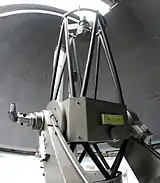Nasmyth telescope
The Nasmyth telescope, also called Nasmyth–Cassegrain or Cassegrain–Nasmyth, is a reflecting telescope developed by the Scottish inventor James Nasmyth. It is a modified form of a Cassegrain telescope, with light reflected sideways before reaching the primary mirror again.


Scheme
As in the Cassegrain telescope, the light falls on a concave primary mirror, then is reflected towards a convex secondary mirror. A comparatively small tertiary flat mirror reflects the light to one of the sides of the telescope. (The central hole in the primary mirror may still host a Cassegrain focus if the tertiary can be moved out of the way.) This flat mirror is placed on the altitude axis, so that the beam exits through a hole in the middle of the altitude bearing. This means the eyepiece or instrument does not need to move up and down with the telescope as the tertiary mirror's angle with the main telescope axis is adjustable as a function of the telescope's pointing and the star's elevation above the horizon; therefore a heavy instrument can be used without upsetting the balance of the telescope or increasing the load on the altitude bearings. This has significant advantages for spectrographs and other heavy instruments typically used at research observatories. Most modern research telescopes can be configured into a Nasmyth telescope (i.e. to use the "Nasmyth Focus").
Observatories
The twin 10-meter telescopes at W. M. Keck Observatory in Hawaii and the 8.2-meter Subaru Telescope sited next to them support an array of specialized instruments on Nasmyth platforms, with a similar design being used for the future Thirty Meter Telescope. The 2.4-meter Automated Planet Finder telescope at Lick Observatory in California supports the use of two Nasmyth foci. The Sierra Nevada Observatory (OSN) in Spain has two Nasmyth telescopes, including a 1.5-meter diameter aperture one. The SOFIA airborne telescope also uses this design.
External links
| Wikimedia Commons has media related to Nasmyth-Cassegrain telescopes. |